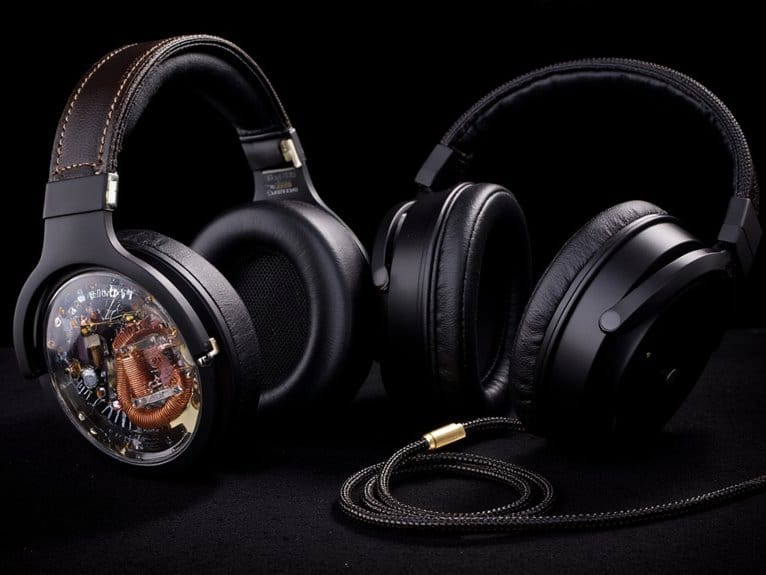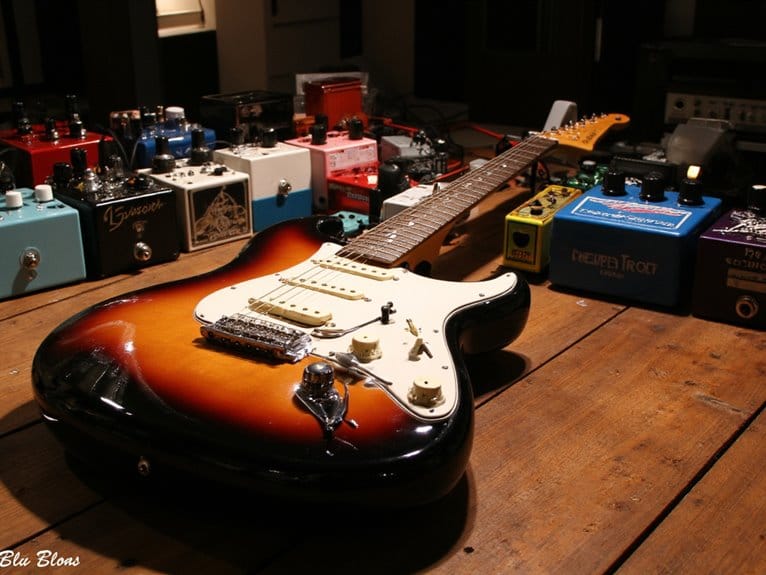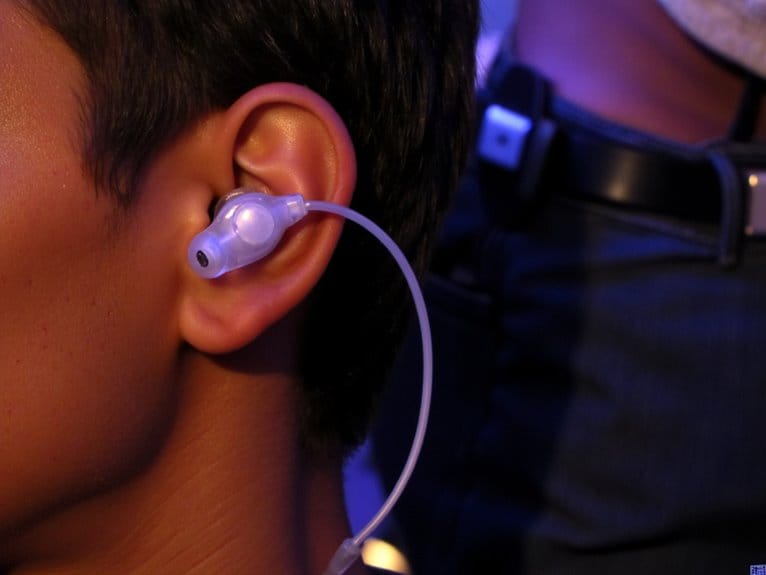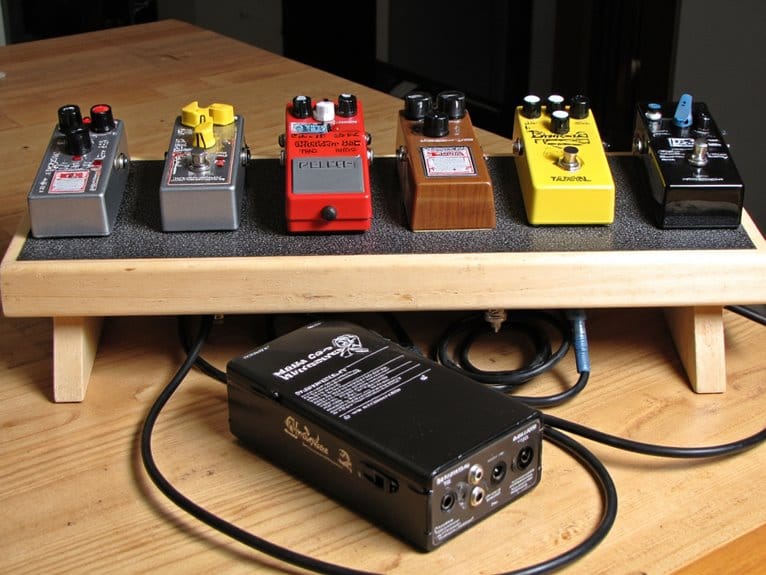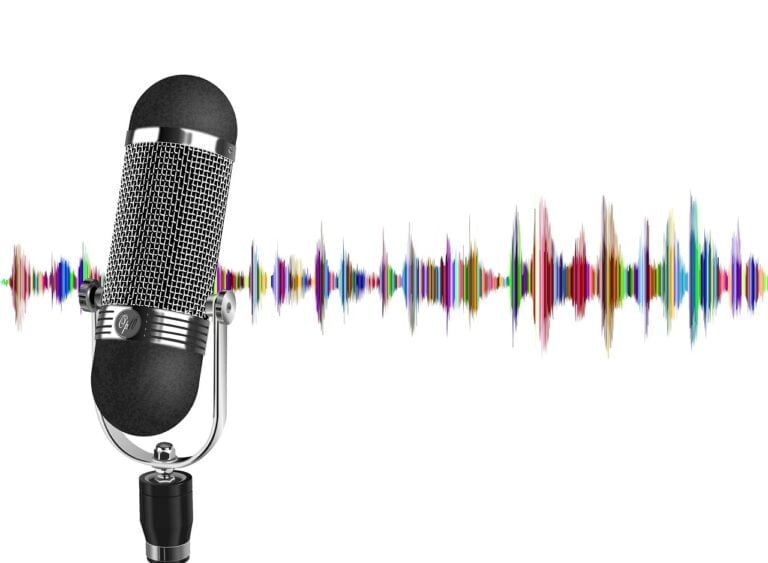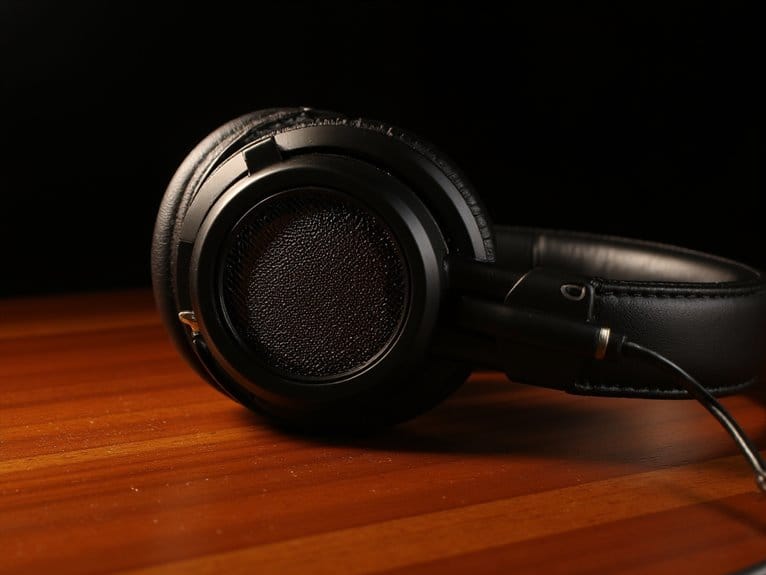Understanding Headphone Impedance and Sensitivity
Headphone sensitivity, measured in dB/mW, determines how loud your headphones get from a given power input, while impedance, measured in ohms, indicates electrical resistance that affects compatibility with your devices. You’ll want low impedance headphones (under 32Ω) with high sensitivity ratings (above 100 dB/mW) for smartphones, since they provide adequate volume without draining battery. Higher impedance models often deliver superior sound quality but require dedicated amplifiers to reach their potential, making proper matching essential for peak performance that we’ll explore further.
We are supported by our audience. When you purchase through links on our site, we may earn an affiliate commission, at no extra cost for you. Learn more.
Notable Insights
- Impedance measures electrical resistance in ohms, with low impedance (<32Ω) headphones working best with smartphones and portable devices.
- Sensitivity indicates sound output efficiency per power unit, measured in dB/mW, with higher ratings producing louder volumes.
- High sensitivity (>100 dB/mW) combined with low impedance creates ideal pairings for phones and other low-powered audio sources.
- High impedance headphones (>100Ω) require dedicated amplifiers but often deliver superior sound resolution and dynamic response.
- Mismatched impedance and sensitivity can cause distortion, noise interference, or inadequate volume levels affecting overall audio quality.
What Sensitivity Means for Your Headphones
When you’re shopping for headphones, sensitivity acts like a car’s fuel efficiency rating, telling you how much sound output you’ll get from each unit of power your device provides.
Measured in decibels per milliwatt (dB/mW), sensitivity shows how efficiently your headphones convert electrical signals into actual sound you can hear. Higher sensitivity ratings mean louder volumes from the same power input, which translates to better audio efficiency when you’re using smartphones, tablets, or other portable devices with limited amplification.
If you frequently listen through low-powered sources, choosing headphones with sensitivity ratings above 100 dB/mW guarantees you won’t struggle to achieve adequate volume levels, while also extending your device’s battery life through reduced power consumption. Models with exceptional battery life like the Sony WH-CH520’s 50-hour performance demonstrate how efficient power management benefits overall listening experience. However, lower sensitivity ratings usually mean quieter volumes with performance significantly affected by your power supply.
Budget headphones with proper sensitivity ratings often deliver 90% noise reduction while maintaining competitive sound quality within their price bracket. These features make them a popular choice for consumers seeking value without sacrificing performance. For those unfamiliar with the technology, ‘noisecanceling headphones explained‘ can shed light on how these devices effectively filter out unwanted background sounds. This knowledge can help buyers make informed decisions when choosing the right headphones for their needs.
Understanding both sensitivity and impedance helps in determining headphone compatibility with your specific devices and listening setup.
Headphone Impedance Explained
Electrical resistance might seem like an abstract concept, but in headphones, it’s the fundamental force that determines whether you’ll need to crank your phone’s volume to maximum or invest in a dedicated amplifier to achieve satisfying sound levels.
Measured in ohms (Ω), impedance quantifies how much opposition your headphones present to electrical current flowing through their voice coils. Different headphone types exhibit varying impedance ranges: low-impedance models under 32Ω work seamlessly with smartphones, medium-impedance options between 33-100Ω benefit from portable amplifiers, while high-impedance variants above 100Ω demand dedicated amplification equipment.
These impedance effects directly impact your listening experience, as higher-ohm headphones require more voltage to reach comfortable volumes but often deliver superior sound resolution and dynamic response through their lighter, thinner voice coil construction. Professional models like the Beyerdynamic DT 990 Pro at 250 ohms demonstrate how proper impedance matching to high-quality amplification delivers superior audio fidelity and reduced distortion. When connecting headphones to guitar amps, matching the impedance rating to your amplifier becomes crucial for achieving optimal sound quality and preventing potential audio issues.
How Sensitivity and Impedance Work Together
Impedance tells only half the story of how your headphones will perform with different audio sources, because sensitivity-measured in decibels per milliwatt (dB/mW)-determines how efficiently those drivers convert electrical power into actual sound pressure that reaches your ears.
Sensitivity matters just as much as impedance when choosing headphones that match your audio source’s power output capabilities.
These two specifications work as a team, where high sensitivity paired with low impedance typically means your smartphone can drive them effectively, while low sensitivity with high impedance creates demanding power requirements that’ll leave you frustrated with weak volume.
Consider these combinations for ideal impedance matching:
- Below 32Ω + high sensitivity: Perfect for portable devices
- 33-100Ω + moderate sensitivity: Requires capable sources or portable amps
- Above 100Ω + low sensitivity: Demands dedicated amplification
- Varying impedance curves: Creates uneven audio dynamics across frequencies
For music production and beat making, sensitivity ratings around 110 dB are particularly crucial for detecting quiet elements and subtle details in your mixes that might otherwise go unnoticed with less sensitive drivers. Using studio headphones for recording ensures that you capture the full range of frequencies and intricacies in your sound. This heightened sensitivity allows for a more accurate representation of your tracks, enabling you to make better mixing decisions. Ultimately, investing in high-quality headphones can significantly enhance the overall quality of your production work.
Audio Performance and Sound Quality Impacts
While impedance and sensitivity specs might look like boring numbers on a product page, they’re actually the secret sauce that determines whether your headphones will sing beautifully or sound like they’re trapped underwater.
When these specifications align properly with your amplifier’s capabilities, you’ll experience enhanced sound clarity across all frequencies, with tight bass response, detailed midrange, and crisp treble definition.
However, mismatched impedance creates significant distortion risk, particularly when underpowered high-impedance headphones struggle to reproduce dynamic passages accurately.
Low-impedance designs paired with weak sources often suffer from signal degradation and noise interference, while excessively sensitive drivers can introduce harshness at higher volumes, compromising your listening comfort and overall audio fidelity.
Choosing the Right Headphones for Your Device
When you’re standing in front of a wall of headphones at your local electronics store, the maze of technical specifications can feel overwhelming.
But I’ve learned that understanding how to match your headphones to your specific devices is actually the difference between audio bliss and buyer’s remorse.
Here’s what I consider when pairing headphone types with my gear:
- For smartphones and portable players: Look for low impedance (16-32Ω) with high sensitivity ratings
- For desktop setups: Higher impedance options work well with dedicated amplifiers
- For gaming consoles: Mid-range impedance typically provides the best balance
- For professional use: Consider amplifier requirements alongside your workflow needs
Recommended brands like Sennheiser, Audio-Technica, and Sony offer clear impedance specifications, making device matching straightforward when you understand these fundamentals.
Frequently Asked Questions
Can High Impedance Headphones Damage My Smartphone or Laptop Audio Output?
High impedance headphones won’t damage your smartphone or laptop’s audio output. These high impedance effects actually reduce current draw, ensuring smartphone safety. You’ll experience lower volume levels rather than any harmful impact on your device’s circuitry.
Will Using a Headphone Amplifier Improve Sound Quality on Any Headphones?
Not necessarily. While amplifier benefits include reduced distortion and better dynamics, headphone compatibility matters most. You’ll notice improvements with high-impedance or low-sensitivity models, but efficient headphones may show minimal gains from dedicated amplification.
On a final note
You’ll find that understanding impedance and sensitivity isn’t as complex as it initially seems, though I’ll admit these specs confused me for years. When you’re shopping for headphones, you’ll want to match these characteristics with your source device’s capabilities, ensuring ideal volume levels and sound quality. Don’t overthink it-focus on compatibility with your phone, amp, or audio interface, and you’ll enjoy better performance from your investment.

